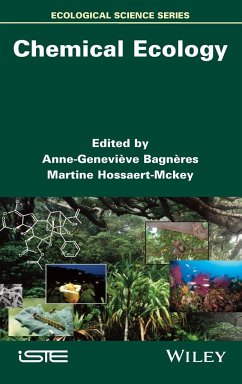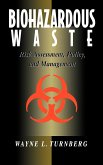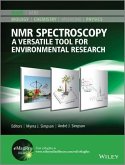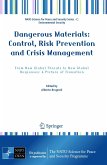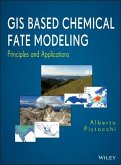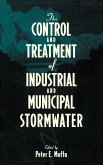Chemical Ecology
Herausgeber: Bagnères, Anne-Geneviève; Hossaert-Mckey, Martine
Chemical Ecology
Herausgeber: Bagnères, Anne-Geneviève; Hossaert-Mckey, Martine
- Gebundenes Buch
- Merkliste
- Auf die Merkliste
- Bewerten Bewerten
- Teilen
- Produkt teilen
- Produkterinnerung
- Produkterinnerung
The book features comparative perspectives on the field of chemical ecology, present and future, offered by scientists from a wide variety of disciplines. The scientists contributing to this book -biologists, ecologists, biochemists, chemists, biostatisticians - are interested in marine, freshwater and terrestrial ecosystems and work on life forms ranging from micro-organisms to mammals, including humans, living in areas from the tropics to polar regions. Here, they cross their analyses of the present state of chemical ecology and its perspectives for the future. Those presented here include…mehr
Andere Kunden interessierten sich auch für
![Hazardous Materials Reference Book Hazardous Materials Reference Book]() Daniel J DavisHazardous Materials Reference Book204,99 €
Daniel J DavisHazardous Materials Reference Book204,99 €![Biohazardous Waste Biohazardous Waste]() Wayne L TurnbergBiohazardous Waste251,99 €
Wayne L TurnbergBiohazardous Waste251,99 €![NMR Spectroscopy NMR Spectroscopy]() NMR Spectroscopy162,99 €
NMR Spectroscopy162,99 €![Dangerous Materials: Control, Risk Prevention and Crisis Management Dangerous Materials: Control, Risk Prevention and Crisis Management]() Dangerous Materials: Control, Risk Prevention and Crisis Management187,99 €
Dangerous Materials: Control, Risk Prevention and Crisis Management187,99 €![Sustainable Materials Science - Environmental Metallurgy Sustainable Materials Science - Environmental Metallurgy]() Jean-Pierre BiratSustainable Materials Science - Environmental Metallurgy322,50 €
Jean-Pierre BiratSustainable Materials Science - Environmental Metallurgy322,50 €![GIS Based Chemical Fate Modeling GIS Based Chemical Fate Modeling]() Alberto PistocchiGIS Based Chemical Fate Modeling190,99 €
Alberto PistocchiGIS Based Chemical Fate Modeling190,99 €![The Control and Treatment of Industrial and Municipal Stormwater The Control and Treatment of Industrial and Municipal Stormwater]() The Control and Treatment of Industrial and Municipal Stormwater265,99 €
The Control and Treatment of Industrial and Municipal Stormwater265,99 €-
-
-
The book features comparative perspectives on the field of chemical ecology, present and future, offered by scientists from a wide variety of disciplines. The scientists contributing to this book -biologists, ecologists, biochemists, chemists, biostatisticians - are interested in marine, freshwater and terrestrial ecosystems and work on life forms ranging from micro-organisms to mammals, including humans, living in areas from the tropics to polar regions. Here, they cross their analyses of the present state of chemical ecology and its perspectives for the future. Those presented here include complex, multispecies communities and cover a wide range both of organisms and of the types of molecules that mediate the interactions between them. Up to now, no book has presented a solid scientific treatment of a wide range of examples. This book illustrates a diverse panel of the most advanced aspects of this rapidly expanding field.
Hinweis: Dieser Artikel kann nur an eine deutsche Lieferadresse ausgeliefert werden.
Hinweis: Dieser Artikel kann nur an eine deutsche Lieferadresse ausgeliefert werden.
Produktdetails
- Produktdetails
- Verlag: Wiley
- Seitenzahl: 244
- Erscheinungstermin: 29. August 2016
- Englisch
- Abmessung: 240mm x 161mm x 18mm
- Gewicht: 531g
- ISBN-13: 9781848219243
- ISBN-10: 1848219245
- Artikelnr.: 44002455
- Herstellerkennzeichnung
- Libri GmbH
- Europaallee 1
- 36244 Bad Hersfeld
- gpsr@libri.de
- Verlag: Wiley
- Seitenzahl: 244
- Erscheinungstermin: 29. August 2016
- Englisch
- Abmessung: 240mm x 161mm x 18mm
- Gewicht: 531g
- ISBN-13: 9781848219243
- ISBN-10: 1848219245
- Artikelnr.: 44002455
- Herstellerkennzeichnung
- Libri GmbH
- Europaallee 1
- 36244 Bad Hersfeld
- gpsr@libri.de
Anne-GenevieÌve Bagnères is Director of Research at the Centre National de la Recherche Scientifique (CNRS). Her scientific interests are chemical communication and the evolutionary ecology of insects and, more specifically, social insects. She is the leader of a group of more than 250 French researchers (MediatEC) specialized in chemical ecology. She is a long-time member of the ISCE (International Society of Chemical Ecology). Martine Hossaert-McKey is a senior scientist at CEFE-CNRS, and a Scientific Deputy Director of the CNRS-Institute Ecology Environment. A specialist in chemical ecology, she works on the intricate sets of co-evolved interactions between fig species, their species-specific pollinators, their parasites and seed-dispersers.
Foreword xi
Stéphanie THIÉBAULT and Françoise GAILL
Introduction xiii
Anne-Geneviève BAGNÈRES and Martine HOSSAERT-MCKEY
Chapter 1. Biodiversity and Chemical Mediation 1
Bertrand SCHATZ, Doyle MCKEY and Thierry PÉREZ
1.1. Systematic and integrative taxonomy from chemical ecology 2
1.2. Scent communication between sexual partners 4
1.3. Scent communication between species 6
1.4. Chemical mimicry, to enhance reproduction 8
1.5. A dialog that sometimes evolves into an interaction network 10
1.6. Conclusions 18
1.7. Bibliography 18
Chapter 2. Chemical Ecology: An Integrative and Experimental Science 23
Anne-Marie CORTESERO, Magali PROFFIT, Christophe DUPLAIS and Frédérique
VIARD
2.1. Semiochemicals 23
2.2. Chemical ecology in multitrophic networks and co-evolution between
species 28
2.3. Contribution of chemical ecology to the study of tropical plant
diversification 32
2.4. When chemical ecology sheds light on the process of biological
invasion - an example demonstrating
integration between chemistry and ecology 36
2.5. Protection is in the air: how plants defend themselves against
phytophagous insects through VOC emissions 40
2.6. Conclusions 43
2.7. Bibliography 43
Chapter 3. Scents in the Social Life of Non-Human and Human Primates 47
Marie CHARPENTIER, Guillaume ODONNE and Benoist SCHAAL
3.1. Primate societies and their complex systems of communication 47
3.2. The role of odors in human communication 53
3.2.1. Human odors convey a large panel of cues 53
3.2.2. Body odors reflect internal states 55
3.2.3. What are the functions of social smells in human daily life? 56
3.2.4. Human pheromones, fact or fiction? 59
3.3. The senses of smell and taste in the search for food and remedies 61
3.3.1. Interactions between senses and food in primates 61
3.3.2. Senses and self-medication in animals 62
3.3.3. Senses in human therapies 63
3.3.4. An evolutionary conception of the link between senses and health 65
3.4. Conclusions - the adaptive functions of the sense of smell in
"microsmatic" species 66
3.5. Bibliography 68
Chapter 4. Microbiota and Chemical Ecology 71
Soizic PRADO, Catherine LEBLANC and Sylvie REBUFFAT
4.1. The protagonist microorganisms of chemical ecology 71
4.2. Strategies for the study of microbiota 72
4.2.1. How should the microbiota be characterized? 72
4.2.2. What tools are available to help understand the roles of the
microbiota? 73
4.3. The molecular dialog of microorganisms 75
4.3.1. Language and social life of microorganisms 75
4.3.2. The AMPs, main actors in the equilibrium of bacterial communities
78
4.3.3. Fungi and bacteria communicate to better help each other 79
4.3.4. When helping each other degenerates into chemical warfare between
bacteria and fungi 80
4.3.5. The Trichoderma fungi: heavy artillery against pathogenic fungi 80
4.4. Chemical communication between microorganisms and their hosts 81
4.4.1. Plant-bacteria relationships: essential interactions with different
partners 81
4.4.2. Plants also establish intimate relations with fungi 83
4.4.3. Mutualist actinobacteria provide care to insects 85
4.4.4. Chemical communication between microorganisms and their host in the
marine environment 87
4.5. Regulations and evolution of the interactions in changing ecosystems
and environments 89
4.5.1. Contribution of chemical ecology to the understanding of
biosynthesis mechanisms of chemical mediators 90
4.5.2. Metabolic networks: new tools for studying the evolution of
host/microbiota interactions 91
4.6. Conclusions - from chemical ecology to future applications: impacts of
the study of the microbiota 91
4.7. Bibliography 92
Chapter 5. From Chemical Ecology to Ecogeochemistry 95
Catherine FERNANDEZ, Virginie BALDY and Nadine LE BRIS
5.1. Balance between primary and secondary metabolism 96
5.2. Role of secondary metabolites in biotic interactions and community
structure 99
5.3. Secondary metabolites and ecosystem functioning: plant soil relation -
brown food chain 103
5.4. Integration of biotic and abiotic dynamics: benthic marine
microhabitats 109
5.5. Conclusions 114
5.6. Bibliography 114
Chapter 6. Omics in Chemical Ecology 117
Sylvie BAUDINO, Christophe LUCAS and Carole SMADJA
6.1. Introduction: the different "omic" technologies 118
6.2. From "omics" to signals: identifying new active molecules 120
6.3. From "omics" to the ecology of communities: identifying chemical
interactions of organisms in their environment 121
6.4. From "omics" to molecular bases: revealing the genetic and molecular
bases of chemical interactions 122
6.5. From "omics" to physiology: characterizing the modes of production and
the modes of reception of active molecules 127
6.6. From "omics" to the role of environment: understanding the impact of
biotic and abiotic factors on interactions 128
6.7. From "omics" to evolution: understanding and predicting the adaptive
value of chemical interactions 131
6.8. Conclusions and perspectives 133
6.9. Bibliography 134
Chapter 7. Metabolomic Contributions to Chemical Ecology 139
Philippe POTIN, Florence NICOLÈ and Olivier P. THOMAS
7.1. Definition of metabolomics 139
7.2. Different strategies of the metabolomic approaches 140
7.3. The different steps for conducting a metabolomic study 141
7.3.1. Experimental design and sampling 142
7.3.2. Analytical approaches 144
7.3.3. Data processing 144
7.4. Applications of metabolomics 151
7.4.1. Chemical biodiversity and chemotaxonomy 151
7.4.2. Study of the regulation and evolution of metabolic/ biosynthesis
pathways 152
7.4.3. Contributions to functional ecology 155
7.4.4. Application of metabolomics to the study of environmental
disturbances 157
7.5. Conclusions 157
7.6. Bibliography 158
Chapter 8. Chemical, Biological and Computational Tools in Chemical
Ecology 161
Nicolas BARTHÈS, Jean-Claude CAISSARD, Jérémy JUST and Xavier FERNANDEZ
8.1. Chemical tools 161
8.1.1. Analytical tools of chromatography 161
8.1.2. Analytical approach by nuclear magnetic resonance 168
8.1.3. Secondary metabolite imagery techniques 170
8.2. Sequencing tools 173
8.2.1. Principles, strengths and limitations of NGS 174
8.2.2. Major domains of NGS applications 175
8.3. Databases: biodiversity in silico 179
8.3.1. Databases of chemical compounds and general ecology 180
8.3.2. Databases for the omics that can be used in chemical ecology 181
8.4. Conclusions 183
8.5. Bibliography 183
Chapter 9. Academic and Economic Values of Understanding Chemical
Communication 185
Bernard BANAIGS, Ali AL MOURABIT, Guillaume CLAVE and Claude GRISON
9.1. Nature as a model 185
9.2. Nature as a model for development of new molecules of interest 187
9.2.1. From chemical mediators to new bioactive structural archetypes 188
9.2.2. Biosynthesis and biomimetic synthesis 192
9.2.3. Chemical mediators and ligand/receptor interactions: to the
discovery of new cellular receptors and biochemical tools 195
9.3. Chemical ecology and sustainable development 196
9.3.1. Bio-control 198
9.3.2. Bio-inspired chemistry and remedial phytotechnologies 200
9.4. Conclusions 205
9.5. Bibliography 205
Conclusion 207
Martine HOSSAERT-MCKEY and Anne-Geneviève BAGNÈRES
Glossary 213
List of Authors 217
Index 221
Stéphanie THIÉBAULT and Françoise GAILL
Introduction xiii
Anne-Geneviève BAGNÈRES and Martine HOSSAERT-MCKEY
Chapter 1. Biodiversity and Chemical Mediation 1
Bertrand SCHATZ, Doyle MCKEY and Thierry PÉREZ
1.1. Systematic and integrative taxonomy from chemical ecology 2
1.2. Scent communication between sexual partners 4
1.3. Scent communication between species 6
1.4. Chemical mimicry, to enhance reproduction 8
1.5. A dialog that sometimes evolves into an interaction network 10
1.6. Conclusions 18
1.7. Bibliography 18
Chapter 2. Chemical Ecology: An Integrative and Experimental Science 23
Anne-Marie CORTESERO, Magali PROFFIT, Christophe DUPLAIS and Frédérique
VIARD
2.1. Semiochemicals 23
2.2. Chemical ecology in multitrophic networks and co-evolution between
species 28
2.3. Contribution of chemical ecology to the study of tropical plant
diversification 32
2.4. When chemical ecology sheds light on the process of biological
invasion - an example demonstrating
integration between chemistry and ecology 36
2.5. Protection is in the air: how plants defend themselves against
phytophagous insects through VOC emissions 40
2.6. Conclusions 43
2.7. Bibliography 43
Chapter 3. Scents in the Social Life of Non-Human and Human Primates 47
Marie CHARPENTIER, Guillaume ODONNE and Benoist SCHAAL
3.1. Primate societies and their complex systems of communication 47
3.2. The role of odors in human communication 53
3.2.1. Human odors convey a large panel of cues 53
3.2.2. Body odors reflect internal states 55
3.2.3. What are the functions of social smells in human daily life? 56
3.2.4. Human pheromones, fact or fiction? 59
3.3. The senses of smell and taste in the search for food and remedies 61
3.3.1. Interactions between senses and food in primates 61
3.3.2. Senses and self-medication in animals 62
3.3.3. Senses in human therapies 63
3.3.4. An evolutionary conception of the link between senses and health 65
3.4. Conclusions - the adaptive functions of the sense of smell in
"microsmatic" species 66
3.5. Bibliography 68
Chapter 4. Microbiota and Chemical Ecology 71
Soizic PRADO, Catherine LEBLANC and Sylvie REBUFFAT
4.1. The protagonist microorganisms of chemical ecology 71
4.2. Strategies for the study of microbiota 72
4.2.1. How should the microbiota be characterized? 72
4.2.2. What tools are available to help understand the roles of the
microbiota? 73
4.3. The molecular dialog of microorganisms 75
4.3.1. Language and social life of microorganisms 75
4.3.2. The AMPs, main actors in the equilibrium of bacterial communities
78
4.3.3. Fungi and bacteria communicate to better help each other 79
4.3.4. When helping each other degenerates into chemical warfare between
bacteria and fungi 80
4.3.5. The Trichoderma fungi: heavy artillery against pathogenic fungi 80
4.4. Chemical communication between microorganisms and their hosts 81
4.4.1. Plant-bacteria relationships: essential interactions with different
partners 81
4.4.2. Plants also establish intimate relations with fungi 83
4.4.3. Mutualist actinobacteria provide care to insects 85
4.4.4. Chemical communication between microorganisms and their host in the
marine environment 87
4.5. Regulations and evolution of the interactions in changing ecosystems
and environments 89
4.5.1. Contribution of chemical ecology to the understanding of
biosynthesis mechanisms of chemical mediators 90
4.5.2. Metabolic networks: new tools for studying the evolution of
host/microbiota interactions 91
4.6. Conclusions - from chemical ecology to future applications: impacts of
the study of the microbiota 91
4.7. Bibliography 92
Chapter 5. From Chemical Ecology to Ecogeochemistry 95
Catherine FERNANDEZ, Virginie BALDY and Nadine LE BRIS
5.1. Balance between primary and secondary metabolism 96
5.2. Role of secondary metabolites in biotic interactions and community
structure 99
5.3. Secondary metabolites and ecosystem functioning: plant soil relation -
brown food chain 103
5.4. Integration of biotic and abiotic dynamics: benthic marine
microhabitats 109
5.5. Conclusions 114
5.6. Bibliography 114
Chapter 6. Omics in Chemical Ecology 117
Sylvie BAUDINO, Christophe LUCAS and Carole SMADJA
6.1. Introduction: the different "omic" technologies 118
6.2. From "omics" to signals: identifying new active molecules 120
6.3. From "omics" to the ecology of communities: identifying chemical
interactions of organisms in their environment 121
6.4. From "omics" to molecular bases: revealing the genetic and molecular
bases of chemical interactions 122
6.5. From "omics" to physiology: characterizing the modes of production and
the modes of reception of active molecules 127
6.6. From "omics" to the role of environment: understanding the impact of
biotic and abiotic factors on interactions 128
6.7. From "omics" to evolution: understanding and predicting the adaptive
value of chemical interactions 131
6.8. Conclusions and perspectives 133
6.9. Bibliography 134
Chapter 7. Metabolomic Contributions to Chemical Ecology 139
Philippe POTIN, Florence NICOLÈ and Olivier P. THOMAS
7.1. Definition of metabolomics 139
7.2. Different strategies of the metabolomic approaches 140
7.3. The different steps for conducting a metabolomic study 141
7.3.1. Experimental design and sampling 142
7.3.2. Analytical approaches 144
7.3.3. Data processing 144
7.4. Applications of metabolomics 151
7.4.1. Chemical biodiversity and chemotaxonomy 151
7.4.2. Study of the regulation and evolution of metabolic/ biosynthesis
pathways 152
7.4.3. Contributions to functional ecology 155
7.4.4. Application of metabolomics to the study of environmental
disturbances 157
7.5. Conclusions 157
7.6. Bibliography 158
Chapter 8. Chemical, Biological and Computational Tools in Chemical
Ecology 161
Nicolas BARTHÈS, Jean-Claude CAISSARD, Jérémy JUST and Xavier FERNANDEZ
8.1. Chemical tools 161
8.1.1. Analytical tools of chromatography 161
8.1.2. Analytical approach by nuclear magnetic resonance 168
8.1.3. Secondary metabolite imagery techniques 170
8.2. Sequencing tools 173
8.2.1. Principles, strengths and limitations of NGS 174
8.2.2. Major domains of NGS applications 175
8.3. Databases: biodiversity in silico 179
8.3.1. Databases of chemical compounds and general ecology 180
8.3.2. Databases for the omics that can be used in chemical ecology 181
8.4. Conclusions 183
8.5. Bibliography 183
Chapter 9. Academic and Economic Values of Understanding Chemical
Communication 185
Bernard BANAIGS, Ali AL MOURABIT, Guillaume CLAVE and Claude GRISON
9.1. Nature as a model 185
9.2. Nature as a model for development of new molecules of interest 187
9.2.1. From chemical mediators to new bioactive structural archetypes 188
9.2.2. Biosynthesis and biomimetic synthesis 192
9.2.3. Chemical mediators and ligand/receptor interactions: to the
discovery of new cellular receptors and biochemical tools 195
9.3. Chemical ecology and sustainable development 196
9.3.1. Bio-control 198
9.3.2. Bio-inspired chemistry and remedial phytotechnologies 200
9.4. Conclusions 205
9.5. Bibliography 205
Conclusion 207
Martine HOSSAERT-MCKEY and Anne-Geneviève BAGNÈRES
Glossary 213
List of Authors 217
Index 221
Foreword xi
Stéphanie THIÉBAULT and Françoise GAILL
Introduction xiii
Anne-Geneviève BAGNÈRES and Martine HOSSAERT-MCKEY
Chapter 1. Biodiversity and Chemical Mediation 1
Bertrand SCHATZ, Doyle MCKEY and Thierry PÉREZ
1.1. Systematic and integrative taxonomy from chemical ecology 2
1.2. Scent communication between sexual partners 4
1.3. Scent communication between species 6
1.4. Chemical mimicry, to enhance reproduction 8
1.5. A dialog that sometimes evolves into an interaction network 10
1.6. Conclusions 18
1.7. Bibliography 18
Chapter 2. Chemical Ecology: An Integrative and Experimental Science 23
Anne-Marie CORTESERO, Magali PROFFIT, Christophe DUPLAIS and Frédérique
VIARD
2.1. Semiochemicals 23
2.2. Chemical ecology in multitrophic networks and co-evolution between
species 28
2.3. Contribution of chemical ecology to the study of tropical plant
diversification 32
2.4. When chemical ecology sheds light on the process of biological
invasion - an example demonstrating
integration between chemistry and ecology 36
2.5. Protection is in the air: how plants defend themselves against
phytophagous insects through VOC emissions 40
2.6. Conclusions 43
2.7. Bibliography 43
Chapter 3. Scents in the Social Life of Non-Human and Human Primates 47
Marie CHARPENTIER, Guillaume ODONNE and Benoist SCHAAL
3.1. Primate societies and their complex systems of communication 47
3.2. The role of odors in human communication 53
3.2.1. Human odors convey a large panel of cues 53
3.2.2. Body odors reflect internal states 55
3.2.3. What are the functions of social smells in human daily life? 56
3.2.4. Human pheromones, fact or fiction? 59
3.3. The senses of smell and taste in the search for food and remedies 61
3.3.1. Interactions between senses and food in primates 61
3.3.2. Senses and self-medication in animals 62
3.3.3. Senses in human therapies 63
3.3.4. An evolutionary conception of the link between senses and health 65
3.4. Conclusions - the adaptive functions of the sense of smell in
"microsmatic" species 66
3.5. Bibliography 68
Chapter 4. Microbiota and Chemical Ecology 71
Soizic PRADO, Catherine LEBLANC and Sylvie REBUFFAT
4.1. The protagonist microorganisms of chemical ecology 71
4.2. Strategies for the study of microbiota 72
4.2.1. How should the microbiota be characterized? 72
4.2.2. What tools are available to help understand the roles of the
microbiota? 73
4.3. The molecular dialog of microorganisms 75
4.3.1. Language and social life of microorganisms 75
4.3.2. The AMPs, main actors in the equilibrium of bacterial communities
78
4.3.3. Fungi and bacteria communicate to better help each other 79
4.3.4. When helping each other degenerates into chemical warfare between
bacteria and fungi 80
4.3.5. The Trichoderma fungi: heavy artillery against pathogenic fungi 80
4.4. Chemical communication between microorganisms and their hosts 81
4.4.1. Plant-bacteria relationships: essential interactions with different
partners 81
4.4.2. Plants also establish intimate relations with fungi 83
4.4.3. Mutualist actinobacteria provide care to insects 85
4.4.4. Chemical communication between microorganisms and their host in the
marine environment 87
4.5. Regulations and evolution of the interactions in changing ecosystems
and environments 89
4.5.1. Contribution of chemical ecology to the understanding of
biosynthesis mechanisms of chemical mediators 90
4.5.2. Metabolic networks: new tools for studying the evolution of
host/microbiota interactions 91
4.6. Conclusions - from chemical ecology to future applications: impacts of
the study of the microbiota 91
4.7. Bibliography 92
Chapter 5. From Chemical Ecology to Ecogeochemistry 95
Catherine FERNANDEZ, Virginie BALDY and Nadine LE BRIS
5.1. Balance between primary and secondary metabolism 96
5.2. Role of secondary metabolites in biotic interactions and community
structure 99
5.3. Secondary metabolites and ecosystem functioning: plant soil relation -
brown food chain 103
5.4. Integration of biotic and abiotic dynamics: benthic marine
microhabitats 109
5.5. Conclusions 114
5.6. Bibliography 114
Chapter 6. Omics in Chemical Ecology 117
Sylvie BAUDINO, Christophe LUCAS and Carole SMADJA
6.1. Introduction: the different "omic" technologies 118
6.2. From "omics" to signals: identifying new active molecules 120
6.3. From "omics" to the ecology of communities: identifying chemical
interactions of organisms in their environment 121
6.4. From "omics" to molecular bases: revealing the genetic and molecular
bases of chemical interactions 122
6.5. From "omics" to physiology: characterizing the modes of production and
the modes of reception of active molecules 127
6.6. From "omics" to the role of environment: understanding the impact of
biotic and abiotic factors on interactions 128
6.7. From "omics" to evolution: understanding and predicting the adaptive
value of chemical interactions 131
6.8. Conclusions and perspectives 133
6.9. Bibliography 134
Chapter 7. Metabolomic Contributions to Chemical Ecology 139
Philippe POTIN, Florence NICOLÈ and Olivier P. THOMAS
7.1. Definition of metabolomics 139
7.2. Different strategies of the metabolomic approaches 140
7.3. The different steps for conducting a metabolomic study 141
7.3.1. Experimental design and sampling 142
7.3.2. Analytical approaches 144
7.3.3. Data processing 144
7.4. Applications of metabolomics 151
7.4.1. Chemical biodiversity and chemotaxonomy 151
7.4.2. Study of the regulation and evolution of metabolic/ biosynthesis
pathways 152
7.4.3. Contributions to functional ecology 155
7.4.4. Application of metabolomics to the study of environmental
disturbances 157
7.5. Conclusions 157
7.6. Bibliography 158
Chapter 8. Chemical, Biological and Computational Tools in Chemical
Ecology 161
Nicolas BARTHÈS, Jean-Claude CAISSARD, Jérémy JUST and Xavier FERNANDEZ
8.1. Chemical tools 161
8.1.1. Analytical tools of chromatography 161
8.1.2. Analytical approach by nuclear magnetic resonance 168
8.1.3. Secondary metabolite imagery techniques 170
8.2. Sequencing tools 173
8.2.1. Principles, strengths and limitations of NGS 174
8.2.2. Major domains of NGS applications 175
8.3. Databases: biodiversity in silico 179
8.3.1. Databases of chemical compounds and general ecology 180
8.3.2. Databases for the omics that can be used in chemical ecology 181
8.4. Conclusions 183
8.5. Bibliography 183
Chapter 9. Academic and Economic Values of Understanding Chemical
Communication 185
Bernard BANAIGS, Ali AL MOURABIT, Guillaume CLAVE and Claude GRISON
9.1. Nature as a model 185
9.2. Nature as a model for development of new molecules of interest 187
9.2.1. From chemical mediators to new bioactive structural archetypes 188
9.2.2. Biosynthesis and biomimetic synthesis 192
9.2.3. Chemical mediators and ligand/receptor interactions: to the
discovery of new cellular receptors and biochemical tools 195
9.3. Chemical ecology and sustainable development 196
9.3.1. Bio-control 198
9.3.2. Bio-inspired chemistry and remedial phytotechnologies 200
9.4. Conclusions 205
9.5. Bibliography 205
Conclusion 207
Martine HOSSAERT-MCKEY and Anne-Geneviève BAGNÈRES
Glossary 213
List of Authors 217
Index 221
Stéphanie THIÉBAULT and Françoise GAILL
Introduction xiii
Anne-Geneviève BAGNÈRES and Martine HOSSAERT-MCKEY
Chapter 1. Biodiversity and Chemical Mediation 1
Bertrand SCHATZ, Doyle MCKEY and Thierry PÉREZ
1.1. Systematic and integrative taxonomy from chemical ecology 2
1.2. Scent communication between sexual partners 4
1.3. Scent communication between species 6
1.4. Chemical mimicry, to enhance reproduction 8
1.5. A dialog that sometimes evolves into an interaction network 10
1.6. Conclusions 18
1.7. Bibliography 18
Chapter 2. Chemical Ecology: An Integrative and Experimental Science 23
Anne-Marie CORTESERO, Magali PROFFIT, Christophe DUPLAIS and Frédérique
VIARD
2.1. Semiochemicals 23
2.2. Chemical ecology in multitrophic networks and co-evolution between
species 28
2.3. Contribution of chemical ecology to the study of tropical plant
diversification 32
2.4. When chemical ecology sheds light on the process of biological
invasion - an example demonstrating
integration between chemistry and ecology 36
2.5. Protection is in the air: how plants defend themselves against
phytophagous insects through VOC emissions 40
2.6. Conclusions 43
2.7. Bibliography 43
Chapter 3. Scents in the Social Life of Non-Human and Human Primates 47
Marie CHARPENTIER, Guillaume ODONNE and Benoist SCHAAL
3.1. Primate societies and their complex systems of communication 47
3.2. The role of odors in human communication 53
3.2.1. Human odors convey a large panel of cues 53
3.2.2. Body odors reflect internal states 55
3.2.3. What are the functions of social smells in human daily life? 56
3.2.4. Human pheromones, fact or fiction? 59
3.3. The senses of smell and taste in the search for food and remedies 61
3.3.1. Interactions between senses and food in primates 61
3.3.2. Senses and self-medication in animals 62
3.3.3. Senses in human therapies 63
3.3.4. An evolutionary conception of the link between senses and health 65
3.4. Conclusions - the adaptive functions of the sense of smell in
"microsmatic" species 66
3.5. Bibliography 68
Chapter 4. Microbiota and Chemical Ecology 71
Soizic PRADO, Catherine LEBLANC and Sylvie REBUFFAT
4.1. The protagonist microorganisms of chemical ecology 71
4.2. Strategies for the study of microbiota 72
4.2.1. How should the microbiota be characterized? 72
4.2.2. What tools are available to help understand the roles of the
microbiota? 73
4.3. The molecular dialog of microorganisms 75
4.3.1. Language and social life of microorganisms 75
4.3.2. The AMPs, main actors in the equilibrium of bacterial communities
78
4.3.3. Fungi and bacteria communicate to better help each other 79
4.3.4. When helping each other degenerates into chemical warfare between
bacteria and fungi 80
4.3.5. The Trichoderma fungi: heavy artillery against pathogenic fungi 80
4.4. Chemical communication between microorganisms and their hosts 81
4.4.1. Plant-bacteria relationships: essential interactions with different
partners 81
4.4.2. Plants also establish intimate relations with fungi 83
4.4.3. Mutualist actinobacteria provide care to insects 85
4.4.4. Chemical communication between microorganisms and their host in the
marine environment 87
4.5. Regulations and evolution of the interactions in changing ecosystems
and environments 89
4.5.1. Contribution of chemical ecology to the understanding of
biosynthesis mechanisms of chemical mediators 90
4.5.2. Metabolic networks: new tools for studying the evolution of
host/microbiota interactions 91
4.6. Conclusions - from chemical ecology to future applications: impacts of
the study of the microbiota 91
4.7. Bibliography 92
Chapter 5. From Chemical Ecology to Ecogeochemistry 95
Catherine FERNANDEZ, Virginie BALDY and Nadine LE BRIS
5.1. Balance between primary and secondary metabolism 96
5.2. Role of secondary metabolites in biotic interactions and community
structure 99
5.3. Secondary metabolites and ecosystem functioning: plant soil relation -
brown food chain 103
5.4. Integration of biotic and abiotic dynamics: benthic marine
microhabitats 109
5.5. Conclusions 114
5.6. Bibliography 114
Chapter 6. Omics in Chemical Ecology 117
Sylvie BAUDINO, Christophe LUCAS and Carole SMADJA
6.1. Introduction: the different "omic" technologies 118
6.2. From "omics" to signals: identifying new active molecules 120
6.3. From "omics" to the ecology of communities: identifying chemical
interactions of organisms in their environment 121
6.4. From "omics" to molecular bases: revealing the genetic and molecular
bases of chemical interactions 122
6.5. From "omics" to physiology: characterizing the modes of production and
the modes of reception of active molecules 127
6.6. From "omics" to the role of environment: understanding the impact of
biotic and abiotic factors on interactions 128
6.7. From "omics" to evolution: understanding and predicting the adaptive
value of chemical interactions 131
6.8. Conclusions and perspectives 133
6.9. Bibliography 134
Chapter 7. Metabolomic Contributions to Chemical Ecology 139
Philippe POTIN, Florence NICOLÈ and Olivier P. THOMAS
7.1. Definition of metabolomics 139
7.2. Different strategies of the metabolomic approaches 140
7.3. The different steps for conducting a metabolomic study 141
7.3.1. Experimental design and sampling 142
7.3.2. Analytical approaches 144
7.3.3. Data processing 144
7.4. Applications of metabolomics 151
7.4.1. Chemical biodiversity and chemotaxonomy 151
7.4.2. Study of the regulation and evolution of metabolic/ biosynthesis
pathways 152
7.4.3. Contributions to functional ecology 155
7.4.4. Application of metabolomics to the study of environmental
disturbances 157
7.5. Conclusions 157
7.6. Bibliography 158
Chapter 8. Chemical, Biological and Computational Tools in Chemical
Ecology 161
Nicolas BARTHÈS, Jean-Claude CAISSARD, Jérémy JUST and Xavier FERNANDEZ
8.1. Chemical tools 161
8.1.1. Analytical tools of chromatography 161
8.1.2. Analytical approach by nuclear magnetic resonance 168
8.1.3. Secondary metabolite imagery techniques 170
8.2. Sequencing tools 173
8.2.1. Principles, strengths and limitations of NGS 174
8.2.2. Major domains of NGS applications 175
8.3. Databases: biodiversity in silico 179
8.3.1. Databases of chemical compounds and general ecology 180
8.3.2. Databases for the omics that can be used in chemical ecology 181
8.4. Conclusions 183
8.5. Bibliography 183
Chapter 9. Academic and Economic Values of Understanding Chemical
Communication 185
Bernard BANAIGS, Ali AL MOURABIT, Guillaume CLAVE and Claude GRISON
9.1. Nature as a model 185
9.2. Nature as a model for development of new molecules of interest 187
9.2.1. From chemical mediators to new bioactive structural archetypes 188
9.2.2. Biosynthesis and biomimetic synthesis 192
9.2.3. Chemical mediators and ligand/receptor interactions: to the
discovery of new cellular receptors and biochemical tools 195
9.3. Chemical ecology and sustainable development 196
9.3.1. Bio-control 198
9.3.2. Bio-inspired chemistry and remedial phytotechnologies 200
9.4. Conclusions 205
9.5. Bibliography 205
Conclusion 207
Martine HOSSAERT-MCKEY and Anne-Geneviève BAGNÈRES
Glossary 213
List of Authors 217
Index 221

